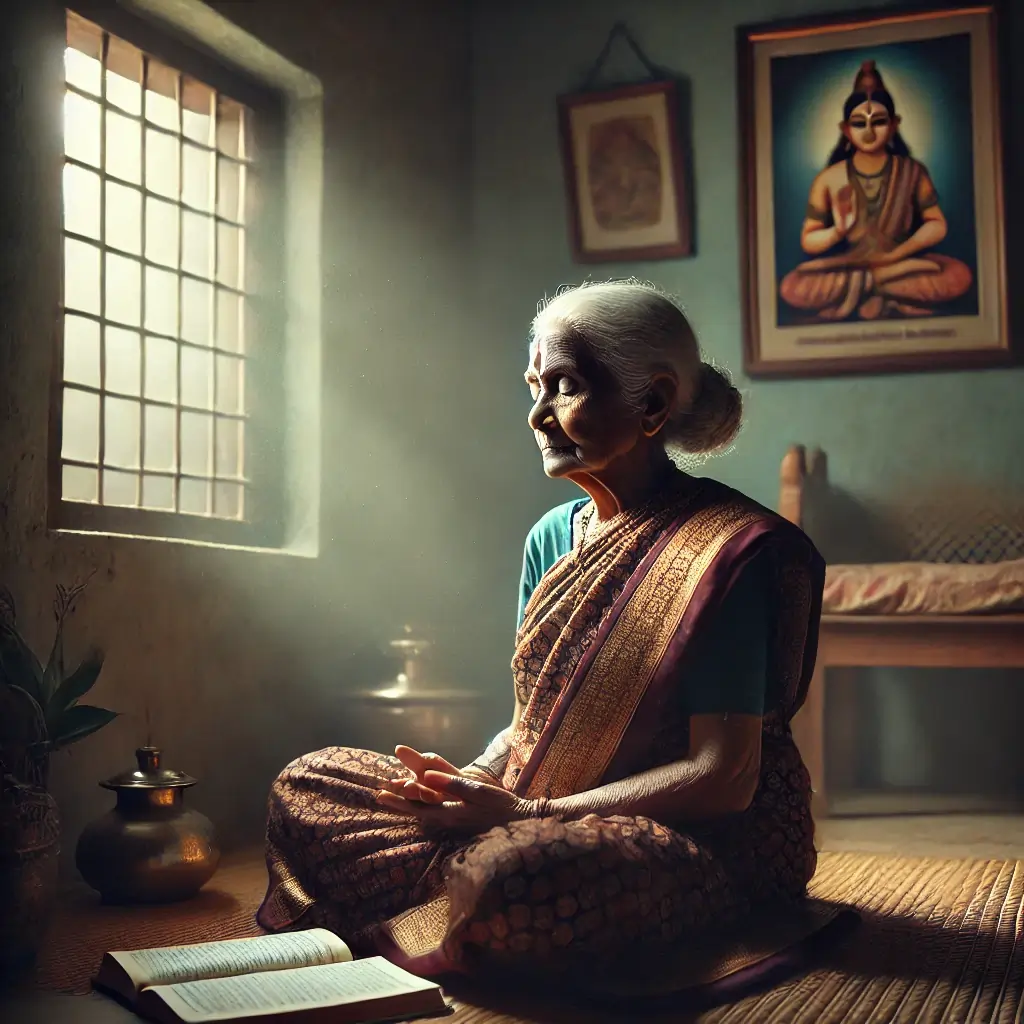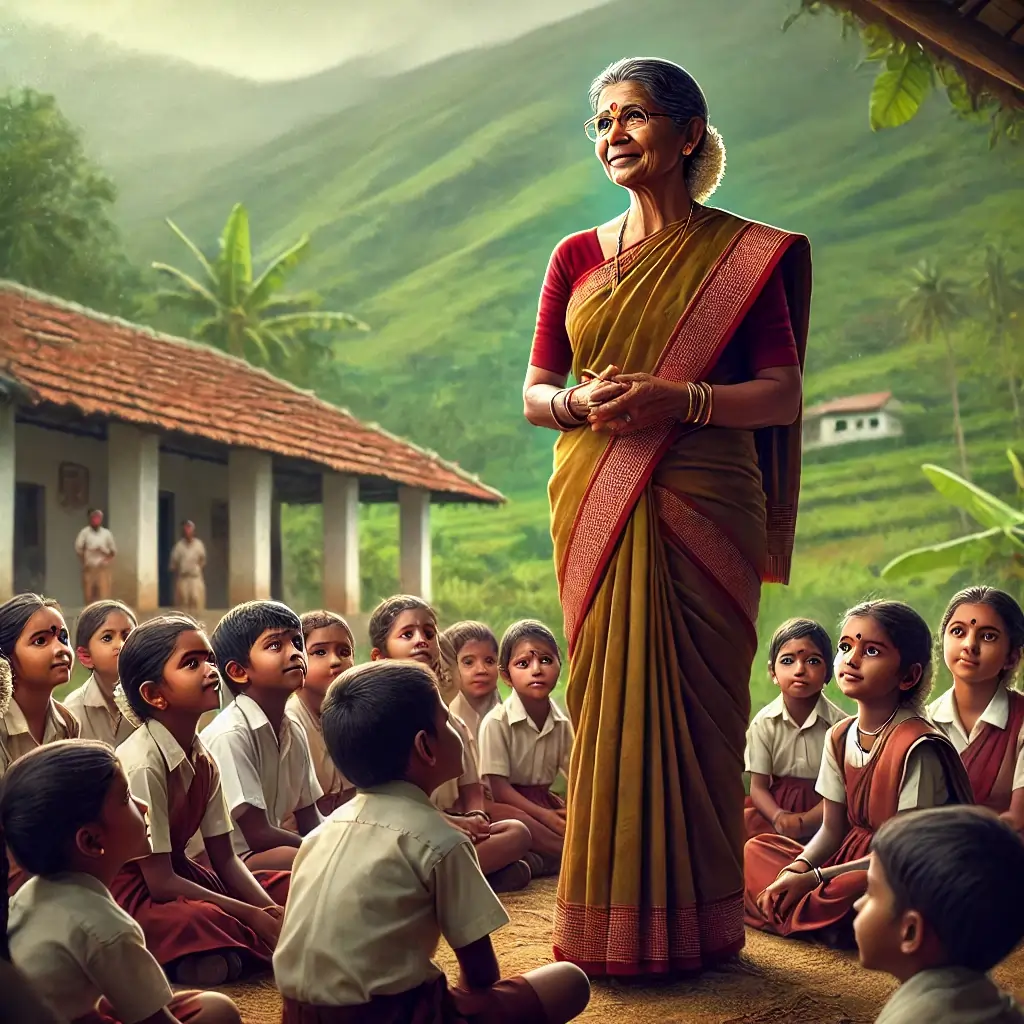A sage explaining karma was asked by the people, “You say that what parents do is borne by their children. If it is sinful karma, how do they experience the consequences as recorded karma?” Similarly, how do virtuous karmas—such as devotion—when practiced by an individual, transmit their positive vibrations to the next generation? How do we recognize this? This post narrates a story to explain that concept.
The Family Tradition of Muthaiya and Andal.
Muthaiya and Andal were a couple whose ancestral roots traced back to Palani. They sustained their family by making vibhuti (sacred ash) and panchamirtham (a traditional sweet) as a cottage industry and selling them to small traders. For generations, their family followed a tradition where, when a child reached the age of seven, they would begin teaching them the Kanda Sashti Kavasam on the Thaipusam of that year. Muthaiya and Andal belonged to the fourth generation upholding this practice.
Muthaiya and Andal had a son and a daughter. Following their family tradition, their son was taught the Kanda Sashti Kavasam at the appropriate age. When their daughter turned seven, it was decided that she would be taught the Kanda Sashti Kavasam on her birthday itself, as she was born on Thaipusam day. Thus, on her birthday, the sacred hymn was introduced to her.
It was on that day that she truly understood the significance of vibhuti (sacred ash). Meanwhile, Muthaiya’s son took part in the family business, assisting his father. The daughter pursued higher education and became a teacher, securing a job in a government school. This school was located in a region inhabited by hill dwellers.
Teaching in the Hills.
She joined the newly established government school, which was the first of its kind in a region with only about fifty families of hill dwellers. Dedicating herself entirely to the children, she worked tirelessly for them year after year. Since the students had to continue their education at a government school located at the foothills after completing the fifth grade, many parents were reluctant to send them. Taking it upon herself, she assumed the responsibility of ensuring that these children continued their education.
The thick morning mist that lasted for hours and the early onset of darkness in the evening made parents hesitant to send their children to school. To ease their fears, the teacher accompanied the children both in the mornings and evenings, ensuring they attended school and continued their education. She firmly believed that if she got married, she would not be able to dedicate herself to these children. With this conviction, she told her father that she did not wish to marry and instead insisted that her brother’s marriage be arranged.
During the quarterly exam holidays, she taught the children Kanda Sashti Kavasam, instilling in them the belief that as long as the sacred hymn remained in their hearts, Lord Muruga would always be by their side. With this faith, the children began reciting Kanda Sashti Kavasam aloud every morning and evening as they walked along the path to and from school. In this way, the teacher nurtured devotion in the hearts of those children.
Only a few children from that school pursued their education beyond the eighth grade by moving to other places. Those who did continued their studies, secured good jobs, and eventually earned a stable income. Out of gratitude, they brought their earnings to their teacher. Overwhelmed with joy, she blessed them wholeheartedly and returned their salaries to them, feeling immense happiness in their success.
The Teacher Retires and Returns to Palani.
Having dedicated her entire life to those children, she found it heartbreaking to leave them. With tears in her eyes, she returned to her parents. In their final years, she took care of them with utmost devotion, ensuring their well-being.
She continued to assist her brother in the family business while taking care of her parents. After fulfilling her duties, she witnessed their passing.
A few years later, she began to feel the effects of aging and recognized the decline in her health. From then on, she spent all her time continuously reciting Kanda Sashti Kavasam in her mind. Eventually, her time came, and she passed away.
The Rebirth of That Woman.
The sage explained that whether one performs good karma or bad karma in their lifetime, they must inevitably be reborn to experience the results of their actions. Therefore, since this woman had accumulated good karma through her deeds, she was reborn to reap its benefits.
In her rebirth, she was born into the family of a temple priest. As she grew up, she followed the same path as her father, dedicating her life to temple service. She had a family with two sons—the elder son was born with great intelligence, while the younger son lacked deep thinking ability and was highly short-tempered.
The younger son was born carrying the burden of his own past sinful karma as well as that of both parents. The period for which he had to endure these karmic consequences was precisely until the age at which his mother, in her previous birth, had begun her service as a teacher and dedicated herself to the children. Similarly, it lasted until the age at which his father in this birth started performing pujas in the temple. At that destined time, Lord Muruga, who had been patiently waiting for the right moment, began to shower his grace upon their second son.

Lord Muruga’s Grace Upon the Younger Son.
One day, the younger son accompanied his father to the temple. Instead of assisting him as instructed, he grew restless, created a commotion, and walked away to sit by the temple pond. Absentmindedly, he began picking up small stones and tossing them into the water. As the ripples formed, he suddenly saw the divine reflection of Lord Muruga appearing in the pond. Realizing that it was none other than the Lord himself, he immediately stood up in awe. In that moment, Lord Muruga’s divine grace descended upon him, transforming his mind and filling him with wisdom. When he returned to his father, something miraculous happened—despite having no knowledge of music, he suddenly began singing devotional hymns in praise of Lord Muruga. Seeing this transformation, his father was overwhelmed with joy, tears of ecstasy streaming down his face. He offered heartfelt praises to Lord Muruga, expressing his gratitude for the divine blessing bestowed upon his son.
Each day, he sat before Lord Muruga and sang with devotion. As the temple was a renowned pilgrimage site, many visitors, including foreigners, frequented it. Some of them recorded his songs on their mobile phones and shared them in their hometowns. Hearing these recordings, members of the Tamil Sangam in that region invited him to sing at their gatherings. Through this opportunity, his life gradually transformed, bringing him prosperity and success.
The Karmic Connections in This Story.
This story primarily revolves around Guru Karma (Jupiter-related karma). In a family, if children are born under the stars Mrigashirsha, Hasta, or Uttarashada—either as their zodiac star, as the star where their ascendant degree falls, or as the star where their ascendant lord is placed—it indicates that they are born carrying Guru Karma as their karmic imprint.
Similarly, individuals with Aries (Mesha), Taurus (Rishabha), or Leo (Simha) ascendants are also considered to be born carrying Guru Karma as their karmic imprint.
Muthaiya’s family, for generations, was born carrying Guru Karma. Their family occupation also revolved around preparing items for divine purposes. His daughter’s profession as a teacher was another manifestation of Guru Karma. Even when she nurtured devotion in children, it created positive vibrations through the influence of Guru Karma.
Due to the influence of Mars Karma’s vibrations, the woman did not consider marriage in her lifetime. In her next birth, her younger son carried the negative vibrations of Mars Karma, which made him short-tempered. However, by the grace of Lord Muruga, when he began singing hymns in devotion to Muruga, the Mars Karma transformed into positive vibrations.
The woman bought bicycles for the children and helped them commute to school. At that time, both Saturn Karma and Rahu Karma created positive vibrations. She dedicated herself entirely to the children, supporting them by traveling to and from the foothills to assist them. This act generated positive Rahu Karma. As a result of these good vibrations, in her next birth, her younger son was able to go abroad and showcase his talents.
The Continuity of Karmas.
Due to the positive vibrations of Mercury Karma, she provided the children with textbooks, pencils, and devotional books, including the Kanda Sashti Kavasam. This act generated positive Mercury Karma vibrations.
In that family, the positive vibrations of Moon Karma and Venus Karma have been passed down through generations. This is why they were engaged in making panchamirtham. Similarly, in their next birth, they continued preparing offerings for the deity. Additionally, since they made sweet offerings, it further generated positive vibrations of Venus Karma.
Since unity prevailed strongly within their family, the positive vibrations of Venus Karma were present. This is why, in the next birth, the younger son went abroad, sang devotional songs, and earned a livelihood through them. The income from this brought prosperity to their family, elevating their standard of living and bringing them happiness. This reflects the positive vibrations of Venus Karma.
The Sage Takes Leave.
The sage, after narrating the story, emphasized the significance of devotion and urged everyone to begin reciting Kanda Sashti Kavasam from the upcoming Thaipusam without fail. He also instructed that it should be recited every morning and evening, assuring that doing so would act as a protective shield and safeguard them. He further explained that when devotion is nurtured in the heart, the divine resides within, and where the divine dwells, there will be no negative thoughts or selfishness. This, in turn, would lead to progress in life. With these blessings, he took leave from everyone.
Om Sri Ganeshaarpanam.
To get a better understanding of karma, please read this
You can read more stories on karma by clicking this link
Or, if you would like to get a more broader perspective of karma and how it is related to the universal consciousness, Brahmam, please read this article
If you would like to know more about DNA astrology, please read this article
If you would like to know what karma you have, please use the DNA software here or simple search for DNA Software in Google or type https://dna.karumbu.in in your browser
Guidelines for using the DNA Astrology software is here

